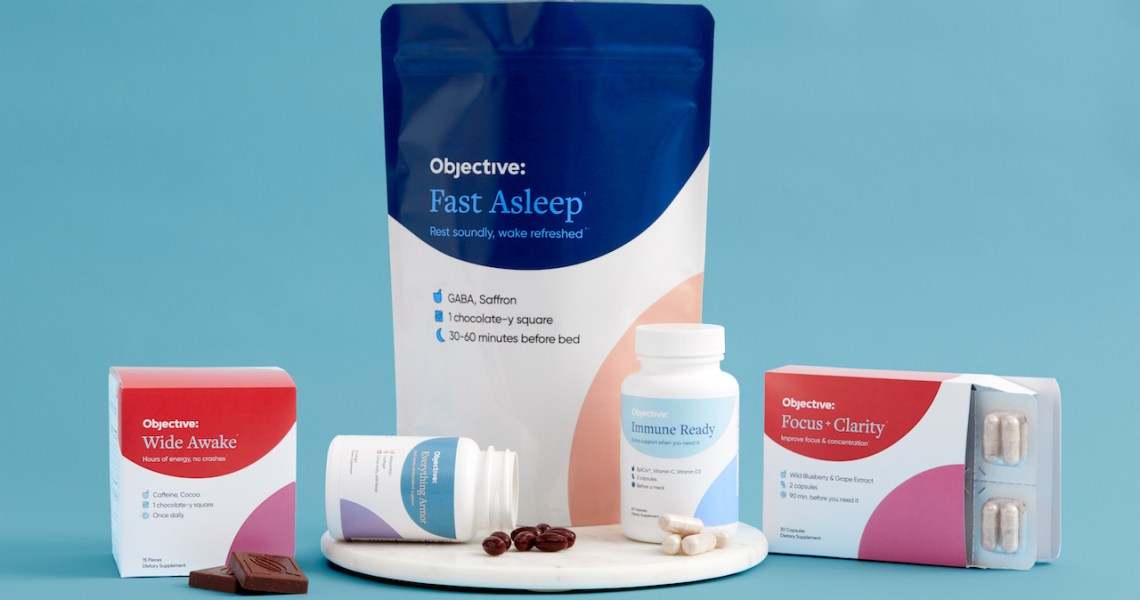When Clorox made the foray into launching a DTC brand last year with its new supplement label Objective, its target market was the “forgotten” generation: Gen X. But when it comes to being a DTC brand, the millennials are hard to avoid.
Objective is revealing a new look on Thursday, including an updated logo, packaging and website to widen its age range appeal to reach millennials that have been the core of most DTC brands’ strategies. The change comes slightly under one year since its November 2019 brand launch. On October 5, it will add another product to its lineup: its Wide Awake instant and extended time-released caffeine chocolates.
The new look is less clinical than the first branding, aimed at “the pain points that we were trying to solve when we went into the rebrand: the original packaging and the original face of Objective being heavily science,” said Kimberly Vandrilla, the head of DTC brand and creative at The Clorox Company. “At the same time, our brand is about people, and the people and the heart of the brand were missing.” The rebrand comes with not only an aesthetic update, but also increased messaging geared toward parents, featuring ideas like “mom strength.”
Added to the logo is a colon after the word “Objective,” changing it from an adjective meaning “we’re an objective third party giving you this information” to a noun referring to an objective as a goal, said Vandrilla.

“Initially, it was really demographic-focused,” said Jackson Jeyanayagam, the vp and gm of DTC businesses at The Clorox Company. “We had brands that were speaking to Boomers, and a lot of brands obviously speaking to millennials and Gen Z, but no one was really focused on Gen X at that time. They’re the ones that have kind of been forgotten. We thought that could be a really great sweet spot for us to build a brand around.”
But they may have been forgotten by DTC brands for a reason: The social media and e-commerce-focused business model resonates more strongly with a millennial audience. The brand’s fastest-growing age segment is millennials ages of 25-34, whose pandemic wellness purchases helped Objective see an overall fourfold increase in sales over FY20 ending in June. According to a 2019 survey by Social Media Link, millennials are the top consumers of DTC brands in the food, beverage and nutrition category, with 39% of them purchasing compared to 31% of Gen X.

Objective’s previous branding. (The Clorox Company)
“We started out targeting this Gen-X audience,” said Vivian Chang, the vp of growth for DTC at Clorox. But as Objective launched new products, especially its line of supplement chocolates, “We started gaining audiences that were actually younger than that original 35-plus target,” said Chang. She said that, currently, 20-25% of the brand’s customer group is this younger demographic.
As a result, the brand is moving more from a “demographic” to a “psychographic” profile, or according to Chang, “less about Gen-X ages, but more about the mentality.” That mentality, namely, is one of overworked parents — long the status of Gen X and one that millennials are now entering into.
Its main social channels are Instagram and Facebook, where it leverages paid and organic engagement as well as influencers. The brand has also built out informational content about wellness on its site, including articles on topics like sleep, immunity and concentration.
“We’re not currently in retail. So, it’s: How do we make sure that our packaging not only pops when they’re scrolling through Instagram, Pinterest or on our site, but also that it’s really easy for someone to get the most important information?” said Chang. The company is also interested in expanding its retail presence beyond e-commerce and is currently in talks with physical retailers, according to Jeyanayagam.

With its focus on parents, the brand has not forgotten about Gen X. “We are still resonating well with these 40-something middles, taking care of their kids, their family,” said Chang. But it’s now the care-taking part that is the focus of the messaging.
“There are a lot of wellness brands out there that are launching every day, targeting a millennial or Gen-Z audience,” said Vandrilla, but she noted that “busy moms and dads” are an “under-served target that’s not spoken to a lot” by brands.
“No one’s really talking to you, and yet you’re the person who’s probably taking care of everyone but yourself — you take care of your parents, take care of your kids,” said Jeyanayagam.
According to Chang, the quick pivot to rebrand is an example of the the brand’s decision to embrace a startup mindset with the resources of a larger conglomerate to support changes. “We launched with a mentality that we were going to let customers tell us where to go really on all aspects of the brand,” she said. “Direct-to-consumer has an advantage in being part of this overall CPG company in that we can test and learn very quickly.”




